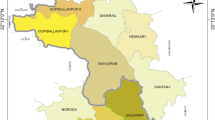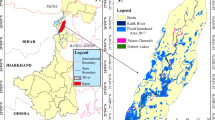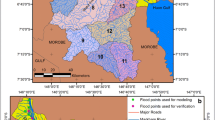Abstract
Natural disasters like flood are causing massive damages to natural and human resources, especially in coastal areas. In respect to social, economic and environmental perspective, flood is one of the most devastating disasters in Chennai for the recent days. Flood susceptibility mapping using frequency ratio model was done for the 88 micro watersheds of Adyar, Cooum and Kosasthalaiyar watersheds of Chennai Corporation area. Flood Susceptibility map was generated using frequency ratio model by considering ten different independent variables (landuse/land cover, elevation, slope, topographic wetness index, surface runoff, landform, lithology, distance from the main river, soil texture and soil drainage) through weighted-based bivariate probability values. In total, 123 historic flood reported locations were taken for this study from which 100 locations were used for susceptibility mapping and 23 locations were used for validation. Both the independent variables and historic flood locations were combined together to generate frequency ratio database for flood susceptibility mapping. The developed frequency ratio was varied from 0 to 27.11 and reclassified into five flood vulnerability zones namely, very low (less than 5.0), low (5.0 7.5), moderate (7.5–10.0), high (10.0–12.5) and very high susceptibility (more than 12.5). The result revealed that 10.48 and 38.93 percentage of the land have very high and high vulnerable class, respectively. The frequency ratio model validated using 23 flood locations, where 22 locations are presented in high and very high susceptibility class. This analysis exemplified that prediction was with success rate of 95.6%. The flood susceptibility analysis using this model will be very useful and efficient tool to the local government administrators, researchers and planners for devising flood mitigation plans.




Similar content being viewed by others
Abbreviations
- FR:
-
Frequency Ratio
- RS:
-
Remote Sensing
- GIS:
-
Geographic Information System
- TWI:
-
Topographic Wetness Index
- NRSC:
-
National Remote Sensing Centre
- SCS:
-
Soil Conservation Service
- AMC:
-
Antecedent soil Moisture Condition
- AHP:
-
Analytical Hierarchy Process
- MCDA:
-
Multi-Criteria Decision support Approach
- WofE:
-
Weights of Evidence
- ANN:
-
Artificial Neural Networks
- NRSC:
-
National Remote Sensing Centre
- SRTM:
-
Shuttle Rader Topographic mission
References
Adiat, K. A. N., Nawawi, M. N. M., & Abdullah, K. (2012). Assessing the accuracy of GIS-based elementary multi criteria decision analysis as a spatial prediction tool–a case of predicting potential zones of sustainable groundwater resources. Journal of Hydrology, 440–41, 75–89.
Amutha, R., & Porchelvan, P. (2009). Estimation of surface runoff in malattar sub-watershed using SCS-CN method. Journal of Indian Society of Remote Sensing, 37(2), 291–304.
BEVEN, K. J., & KIRKBY, M. J. (1979). A physically based variable contributing area model of basin hydrology. Hydrological Sciences Bulletin, 24, 43–69.
Bhatt, C. M., & Mishra, A. (2016). Chennai floods, 2015 (a satellite and field based assessment study). Report of Disaster Management Support Division.
Billa, L., Shattri, M., Mahmud, A. R., & Ghazali, A. H. (2006). Comprehensive planning and the role of SDSS in flood disaster management in Malaysia. Disaster Prevention and Management, 15, 233–240.
Bisht, D. S., Chatterjee, C., Kalakoti, S., Upadhyay, P., Sahoo, M., & Panda, A. (2016). Modeling urban floods and drainage using SWMM and MIKE URBAN: A case study. Natural Hazards, 84(2), 749–776.
Bonham-Carter, G. F. (1994). Geographic information systems for geoscientists: modeling with GIS. In F. Bonham-Carter (Ed.), Computer methods in the geosciences. Oxford: Pergamon press.
Qin, C.-Z., Zhu, A.-X., Pei, T., Li, B.-L., Scholten, T., Behrens, T., & Zhou, C.-H. (2011). An approach to computing topographic wetness index based on maximum downslope gradient. Precision Agriculture, 12, 32–43.
Chen, Y. R., Yeh, C. H., & Yu, B. (2011). Integrated application of the analytic hierarchy process and the geographic information system for flood risk assessment and flood plain management in Taiwan. Natural Hazards, 59(3), 1261–1276.
Faiz-Ahmed, C., & Kranthi, N. (2018). Flood vulnerability assessment using geospatial techniques Chennai India. Indian Journal of Science and Technology., 11(6), 1–13.
Haghizadeh, A., Siahkamari, S., Haghiabi, A. H., & Rahmati, O. (2017). Forecasting flood-prone areas using Shannon’s entropy model. Journal of Earth System Science, 126, 39. https://doi.org/10.1007/s12040-017-0819-x
Huang, X., Tan, H., Zhou, J., Yang, T., Benjamin, A., Wen, S. W., Li, S., Liu, A., Li, X., Fen, S., & Li, X. (2008). Flood hazard in Hunan province of China: an economic loss analysis. Natural Hazards, 47, 65–73.
Jameson, S., & Baud, I. (2016). Varieties of knowledge for assembling an urban flood management governance configuration in Chennai India. Habitat International, 54, 112–123.
Jena, P. P., Panigrahi, B., & Chatterjee, C. (2016). Assessment of Cartosat-1 DEM for modeling floods in data scarce regions. Water Resources Management, 30(3), 1293–1309.
Kumar, P., Tiwari, K. N., & Pal, D. K. (1991). Establishing SCS runoff curve number from IRS digital database. Journal of the Indian Society of Remote Sensing, 19(4), 245–251.
Lavanya, A. K. (2012). Urban Flood Management – A case study of Chennai city. Architecture Research, 2(6), 115–121.
Lee, M.J., Kang, J.E., & Jeon, S. (2012). Application of frequency ratio model and validation for predictive flooded area susceptibility mapping using GIS. In: Proceedings of Geoscience and Remote Sensing Symposium (IGARSS), 2012 IEEE International. Munich, 895–898.
Liao, X., & Carin, L. (2009). Migratory logistic regression for learning concept drift between two data sets with application to UXO sensing. IEEE Transactions on Geoscience and Remote Sensing, 47, 1454–1466.
Lohani, A., Kumar, R., & Singh, R. (2012). Hydrological time series modeling: A comparison between adaptive neuro-fuzzy, neural network and autoregressive techniques. Journal of Hydrology, 442, 23–35.
Manandhar, B. (2010). Flood plain analysis and risk assessment of Lothar Khola. MSc Thesis, Tribhuvan University, Phokara, Nepal, pp. 64.
McGranahan, G., Balk, D., & Anderson, B. (2007). The rising tide assessing the risks of climate change and human settlements in low elevation coastal zones. Environment and Urbanization, 19(1), 17–37.
NDMP. (2016). A publication of the national disaster management authority. Government of India.
Pal, B., & Samanta, S. (2011). Surface runoff estimation and mapping using remote sensing and geographic information system. International Journal of Advanced Science and Technology, 3(2), 106–114.
Pradhan, B., & Buchroithner, M. F. (2010). Comparison and validation of landslide susceptibility maps using an artificial neural network model for three test areas in Malaysia. Environmental and Engineering Geoscience, 16, 107–126.
Rahmati, O., Pourghasemi, H. R., & Zeinivand, H. (2016). Flood susceptibility mapping using frequency ratio and weights-of-evidence models in the Golastan Province Iran. Geocarto International. https://doi.org/10.1080/10106049.2015.1041559
Rao, K. V., Bhattacharya, A. K., & Mishra, K. (1996). Runoff estimation by curve number method-case studies. Journal of Soil and Water Conservation, 40, 1–7.
Regmi, N. R., Giardino, J. R., & Vitek, J. D. (2010). Modeling susceptibility to landslides using the weight of evidence approach: Western Colorado, USA. Geomorphology, 115, 172–187.
Sahoo, D. P., Sahoo, B., & Tiwari, M. K. (2020). Copula-based probabilistic spectral algorithms for high-frequent streamflow estimation. Remote Sensing of Environment, 251, 112092.
Samanta, S., Pal, D. K., & Palsamanta, B. (2018). Flood susceptibility analysis through remote sensing GIS and frequency ratio model. Applied Water Science, 8, 66.
Samanta, S., Pal, D. K., Lohar, D., & Pal, B. (2012). Interpolation of climate variables and temperature modeling. Theoretical and Applied Climatolgy, 107(1), 35–45. https://doi.org/10.1007/s00704-011-0455-3
Samanta, S., Koloa, C., Pal, D. K., & Palsamanta, B. (2016). Flood risk analysis in lower part of Markham River based on multi-criteria decision approach (MCDA). Hydrology., 3(3), 29. https://doi.org/10.3390/hydrology3030029
Sezer, E. A., Pradhan, B., & Gokceoglu, C. (2011). Manifestation of an adaptive neuro-fuzzy model on landslide susceptibility mapping: Klang Valley Malaysia. Expert Systems with Applications, 38(7), 8208–8219.
SCS. (1972). Soil conservation department. Handbook of Hydrology.
Tehrany, M. S., Pradhan, B., & Jebur, M. N. (2015). Flood susceptibility analysis and its verification using a novel ensemble support vector machine and frequency ratio method. Stochastic Environmental Research and Risk Assessment, 29, 1149–1165. https://doi.org/10.1007/s00477-015-1021-9
Tiwari, M. K., & Chatterjee, C. (2010). Uncertainty assessment and ensemble flood forecasting using bootstrap based artificial neural networks (BANNs). Journal of Hydrology, 382(1), 20–33.
WHO (2003). World Health Organization. Disaster data-key trends and statistics in World Disasters Report; WHO: Geneva, Switzerland. http://www.ifrc.org/PageF iles/89755/2003/43800 -WDR2003_En.pdf
Yalcin, A. (2008). GIS-based landslide susceptibility mapping using analytical hierarchy process and bivariate statistics in Ardesen (Turkey): Comparisons of results and confirmations. CATENA, 72, 1–12.
Youssef, A. M., Pradhan, B., & Hassan, A. M. (2011). Flash flood risk estimation along the St.Katherine road, southern Sinai, Egypt using GIS based morphometry and satellite imagery. Environmental Earth Sciences, 62, 611–662.
Acknowledgements
The authors are very grateful to National Centre for Coastal Research (NCCR) of the Ministry of Earth Science (MoES, India) for the financial support and continuous encouragement.
Author information
Authors and Affiliations
Corresponding author
Additional information
Publisher's Note
Springer Nature remains neutral with regard to jurisdictional claims in published maps and institutional affiliations.
About this article
Cite this article
Natarajan, L., Usha, T., Gowrappan, M. et al. Flood Susceptibility Analysis in Chennai Corporation Using Frequency Ratio Model. J Indian Soc Remote Sens 49, 1533–1543 (2021). https://doi.org/10.1007/s12524-021-01331-8
Received:
Accepted:
Published:
Issue Date:
DOI: https://doi.org/10.1007/s12524-021-01331-8




